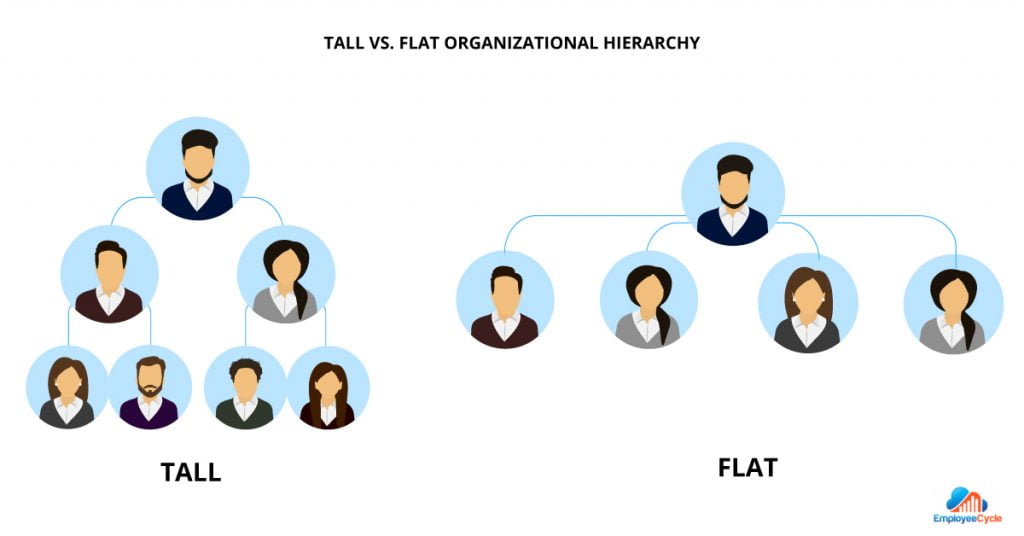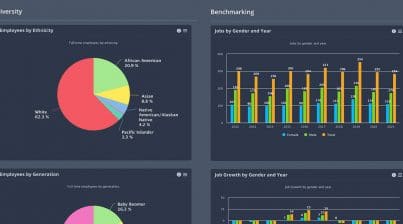Most organizations want to know what the ideal span of control is. Evaluating the span of control is a good health check for your organization. When you go through the exercise of visualizing spans and layers of managers versus direct reports, your company can quickly see where there might be opportunities for improvement or even where the problems reside.
Definition of HR Span of Control
Human Resources (HR) Span of Control, or Management Span, is one of the foundations of management theory. Span of control simply measures the number of direct reports that a manager can manage to an efficient level. When HR is analyzing your organization, span of control depends highly on the organizational structure of your business and calculating the average span of control helps you evaluate whether you need more managers.
Types of Span of Control
There are typically two types of span of control when measuring the ratio of employees to managers:
- Narrow (Tall): This is the traditional view with a manager only having a couple of direct reports, who additionally have a couple of direct reports. The org structure is tall rather than flat.
- Wide (Flat): This is the more modern approach that gives a manager a broader knowledge of the workforce and gives direct reports a single contact person to go to for information and leadership. The org structure is flat rather than tall.

Further, each manager will fulfill two dimensions for the team they manage:
- Horizontal: refers to the number of employees a manager has directly reporting to them.
- Vertical: refers to the number of employees that are indirectly managed by the manager, also known as depth of control.
Measuring Span of Control
Measuring the span of control is simple – count how many direct reports a manager has. These employees are not just under the manager’s control but also have a working relationship with the manager who makes executive decisions.
To measure further, the average span of control is calculated by summing the number of direct relationships a manager has with their direct reports and dividing it by the number of managers.
Sometimes an organization will define its ideal span of control. This is the number of direct reports that a manager should ideally have. There is no right or wrong answer as to whether a large or small span should be used within an organization.
Your company’s ideal span of control will depend on doing what best suits your organization.
Factors That Influence the Average Span of Control
The influential factors are important for your HR and upper management teams to know so they can hypothesize and calculate what kind of management your company needs. Factors to consider are:
- Ability and capacity of the manager and the direct reports. This refers to the manager’s ability to take on many or fewer direct reports. For example, a new manager may be challenged with just one or two direct reports to manage. But an experienced manager will be more efficient and capable, able to control a large number of direct reports. For direct reports, the more skilled and experienced they are, the less likely they are to require help from their manager. In these examples, ability and capacity of both manager and direct reports have an impactful effect on what your span of management will be in your company.
- Availability of time for team leadership. If managers have less time for supervision, they would not be able to control a large number of direct reports.
- Type of work your company offers. In each type of project, service, or product your company offers, some tasks require more micromanagement and resources while others are simple and routine in nature. Tasks that are less dependent allow for a much wider area of control. It’s important to use time tracking to understand the amount of time these tasks take.
- Plans for your organization. If your company has clear and stable plans, then managers typically feel it is easy to control the activities of their direct reports. However, if your company’s plans are not stable or not communicated well, it becomes quite difficult for managers to control the activities of many direct reports.
Advantages and Disadvantages of Large v. Small Span of Control
Large Span of Control:
| Advantages | Disadvantages |
| Faster decision-making due to shallow or flat organization structure | Fewer opportunities for employees because fewer layers offer less opportunity for promotion |
| Lower costs because fewer managers are needed relative to the number of employees | Poor discipline can happen with so much autonomy given to employees |
| Improved communications between managers and employees | Poor relationships because the manager has too many employees to form strong, close bonds |
| More freedom because typically employees will feel freer and less micromanaged | Poor performance due to little supervision of employees |
Small Span of Control:
| Advantages | Disadvantages |
| Easy access to superior when needed in tall organization structure | Employees can feel under constant and close supervision, which can be demotivating |
| Better opportunities for employees to get promoted | Increased layers within the organization can make decision-making slower |
| Closer supervision and greater attention to the needs of the employee | With more layers, communication is not only slower but more difficult for managers to understand the issues |
| Less skill required by the manager |
Measuring span of control can be extremely difficult without data. Being able to unify HR data to support your approach to span of control is essential for HR decision-making. Unify your data from every HR platform your company uses and place it into a single HR data dashboard with Employee Cycle. Make the best decisions for your company and easily leverage the power of clear, easy to access and easy to evaluate HR data that helps you make the best decisions in a matter of seconds.
Looking to utilize the span of control as an HR metric?
Well, you can get your free trial of Employee Cycle’s HR data dashboard software today with your free account here.












